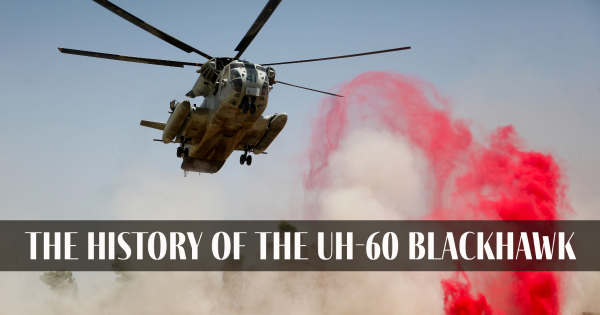Making The Most Of Safety And Security: Important Maintenance Tips for Your UH 60 Helicopter
Understanding the Mechanics and Design Behind Uh 60 Helicopters
The UH-60 helicopter, generally called the Black Hawk, stands as a peak of modern-day rotorcraft modern technology, symbolizing a mix of robust design and complex mechanics. From its creation to its current versions, the development of this aircraft showcases a fusion of technology and functionality. As we peel back the layers of the UH-60's style, a world of complex systems and meticulous engineering comes to light. Understanding the technicians and engineering behind this versatile airplane introduces a world where accuracy meets power, and where each component plays a vital duty in attaining flight.
History of UH-60 Helicopters
The background of UH-60 helicopters traces back to the late 1970s when the USA Army looked for a versatile and advanced energy helicopter to change its aging fleet. In reaction to this demand, the Sikorsky Aircraft Firm created the UH-60 Black Hawk helicopter. Presented in 1979, the UH-60 rapidly came to be a staple in armed forces operations as a result of its impressive capabilities.
The UH-60 was developed to master a selection of missions, including troop transport, clinical evacuation, digital war, and unique procedures. Its ability to adjust to different functions made it a valuable possession to the united state Military and other military forces around the globe
Over the years, the UH-60 system has actually gone through a number of upgrades and variants to enhance its performance and keep pace with developing goal needs. These helicopters have actually seen comprehensive solution in problems such as the Gulf War, Afghanistan, and Iraq, showcasing their reliability and flexibility in diverse operational environments. The UH-60's abundant background is a testament to its long-lasting tradition as a leading utility helicopter.

Engine and Power Solutions
Making use of advanced propulsion technology, UH-60 helicopters are outfitted with innovative engine and power systems to make sure optimum performance and integrity in a variety of operational situations. The UH-60, frequently known as the Black Hawk, is powered by two General Electric T700-GE-701D engines, each with the ability of providing up to 1,940 shaft horsepower. These turboshaft engines offer the needed thrust for the helicopter to lug out its objectives effectively, including troop transportation, clinical discharge, and battle support.

Blades System and Aerodynamics
Just how do the blades system and aerodynamics of UH-60 helicopters add to their operational effectiveness and flight capabilities? The blades system of the UH-60 helicopter plays a crucial function in giving lift and propulsion.
The rules of aerodynamics likewise play a vital role in the performance of UH-60 helicopters. The streamlined fuselage and blades blade style minimize drag, permitting the helicopter to achieve greater rates and much better gas effectiveness. The aerodynamic design of the UH-60 likewise contributes to its capacity to run in varied ecological conditions, consisting of hot temperatures and high elevations.
Avionics and Flight Control Systems

In its detailed control with the rotor system and the rules of aerodynamics of UH-60 helicopters, the avionics and trip control systems form a vital network of innovations shaping the airplane's operational capacities. In the UH-60, these systems consist of digital screens, interaction radios, General practitioner navigating, weather condition radar, and auto-pilot systems.
The flight control systems of the UH-60 are in charge of equating the pilot's inputs into the proper changes to the blades system, making sure steady flight and ability to move. These systems consist of hydraulic actuators, servos, and computer systems that work together to manage the major and tail blades, in addition to other flight control surface areas. By exactly managing the helicopter's trip characteristics, these systems enable pilots to carry out a vast array of objectives, from transportation and search-and-rescue to fight procedures, with precision and confidence.
Function and Applications in Aeronautics
Avionics systems in UH-60 helicopters include a range of digital systems that aid in navigating, interaction, tracking, and regulating different aircraft features. These systems consist of digital display screens, auto-pilot systems, communication radios, GPS navigation devices, and climate radar. Additionally, these systems include pop over to these guys security features such as autopilot modes, terrain understanding cautioning systems, and security enhancement systems to boost the overall safety and operational capabilities of the UH-60 helicopters in various objectives, consisting of army transport, clinical emptying, search and rescue, and aerial firefighting.
Final Thought
To conclude, the UH-60 helicopter is a flexible airplane with a rich background and advanced design. look at this now Its engine and power systems, blades system, the rules of aerodynamics, avionics, and flight control systems all interact to make it a reputable and efficient maker. The UH-60's duty and applications in aviation are huge, varying from military operations to browse and save objectives. Its continued growth and use demonstrate its value in the field of aeronautics (uh 60).
In its detailed control with the rotor system and aerodynamics of UH-60 helicopters, the avionics and trip control systems develop an essential network of modern technologies shaping the airplane's operational capabilities.The flight control systems of the UH-60 are accountable for equating the pilot's inputs into the proper modifications to the blades system, making sure steady trip and maneuverability. Avionics systems in UH-60 helicopters include a range of digital systems that aid in navigation, interaction, monitoring, and regulating different aircraft functions. In addition, these systems include security features such as autopilot modes, terrain awareness cautioning systems, and stability augmentation systems to enhance the total safety and operational capabilities of the UH-60 helicopters in numerous objectives, including troop transport, clinical emptying, like it search and rescue, and airborne firefighting.
Its engine and power systems, rotor system, aerodynamics, avionics, and trip control systems all function with each other to make it a reliable and effective equipment.